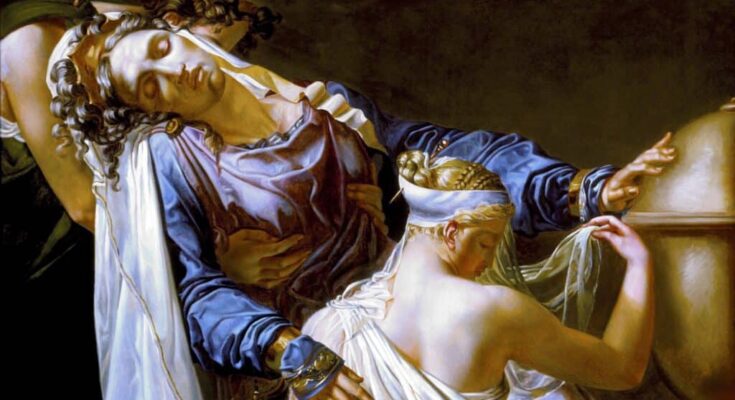
Hecabe (Hecuba), the legendary queen of Troy, is one of the most tragic and intriguing characters in Greek mythology.
Her life was defined and shaped by the destiny of her beloved Troy and the Trojan War. This deep connection to the fate of one of the Greek mythology’s most famous battles has captivated artists and audiences alike for millennia. In addition to her life, the elements and characteristics of her personality inspired numerous works of art and literature, offering beautiful insights into the ancient Greek psyche and the beliefs of the people of that era.
Hecuba was the wife of the famous King of Troy, Priam. She was also the mother of many children, including the legendary Trojan heroes Hector and Paris.
Who were the parents of Hecabe?
As the queen of Troy, Hecuba enjoyed significant power and influence in her family, her city, and beyond. Her lineage differs according to various versions and stories of Greek mythology. Hecabe’s parents are different depending on the source of ancient Greek texts.
Homer, for example, describes Hecabe as the daughter of King Dymas of Phrygia. However, Euripides and Virgil identify her as the daughter of Thracian king Cisseus.
The mythographers Pseudo-Apollodorus as well as Hyginus leave unanswered the question of which of the two her father was, with Pseudo-Apollodorus adding a third possible option: The parents of Hecabe could also be the river deity Sangarius and Metope.
One of the most crucial events in the tumultuous life of Hecabe took place right before the birth of her legendary son, Paris.
While she was pregnant, she had a very disturbing dream in which she gave birth to a fiery torch coated in menacing snakes. This scarily foreboding vision was regarded by Troy’s prophets at the time as a severe warning.
If the infant she was going to give birth to survived and grew up, he would destroy the city with his actions. This dream was a truly powerful omen of impending disaster, a truly scary foreshadowing of the awful events that would indeed occur later on, sealing the tragic fate of Troy and its people.
Hecabe and her role in the Trojan War according to Greek mythology
Hecabe was not merely a witness but had an important role in the Trojan War, based on what we know from Homer’s Iliad. She prayed to the goddess Athena for divine intervention and protection and begged her son Hector not to confront Achilles in combat, as she knew how fearless he was. Her maternal instincts and devotion to her children are qualities that defined her character and personality throughout the popular epic of Homer.
Following the tragic demise of Troy, the life of Hecabe took a sudden, sad turn. She witnessed the brutal murders of her husband and several of her children before being enslaved herself by Odysseus, the Greek hero. Her familial tragedies continued even after the war when she discovered that King Polymestor of Thrace had betrayed and murdered her beloved youngest son, Polydorus.
Driven by utter sadness and vengeful anger, Hecabe decided to take the situation into her own hands. She embarked on a horrific journey of revenge against King Polymestor with the help of other Trojan women who were determined to support their beloved queen.
One day, Hecabe enticed Polymestor with the promise of money, only to suddenly blind him and slaughter his beloved child Deipylus. This act of raw revenge and retribution, however understandable given Hecabe’s extreme suffering, resulted in her eventual transformation as a person.
What Greek mythology tells us about the end of Hecabe
According to numerous versions of ancient Greek mythology, the gods punished Hecabe for crossing important mortal boundaries by transforming her into a dog. According to certain versions of this story, Hecabe leapt into the water, unable to deal with the amount of grief life had brought to her.
The final resting site of Hecabe became known as Cynossema, which is Greek for “the dog’s grave.” It allegedly served as a marker for sailors, who were passing by that area.
The tragic story of Hecabe has influenced many works of literature and art throughout history, as have so many other tales from Greek mythology. She appears prominently in Euripides‘ plays The Trojan Women and Hecabe, which are focused on the aftermath of Troy’s collapse and Hecabe’s pursuit for revenge.
Her persona has been portrayed as a symbol of motherly love, tenacity in the face of enormous tragedy and the devastation caused to humans by war.



